Human TH17 cells express a functional IL-13 receptor and IL-13 attenuates IL-17A production
- PMID: 21236478
- PMCID: PMC3916096
- DOI: 10.1016/j.jaci.2010.11.043
Human TH17 cells express a functional IL-13 receptor and IL-13 attenuates IL-17A production
Abstract
Background: IL-13 is a central mediator of airway responsiveness and mucus expression in patients with allergic airway inflammation, and IL-13 is currently a therapeutic target for asthma. However, little is known about how IL-13 regulates human CD4(+) T-cell lineages because IL-13 receptor (IL-13R) α1, a subunit of IL-13R, has not previously been reported to exist on human T cells.
Objective: We sought to determine whether human CD4(+) T(H)17 cells express IL-13Rα1 and whether IL-13 regulates T(H)17 cytokine production.
Methods: Naive human CD4(+) cells were isolated from whole blood, activated with anti-CD3 and anti-CD28, and polarized to T(H)1, T(H)2, T(H)17, or induced regulatory T cells in the presence of IL-13 (0-10 ng/mL). Cell supernatants, total RNA, or total protein was examined 4 days after T(H)17 polarization.
Results: T(H)17 cells, but not T(H)0, T(H)1, T(H)2, or induced regulatory T cells, expressed IL-13Rα1. IL-13 attenuated IL-17A production, as well as expression of retinoic acid-related orphan receptor, runt-related transcription factor-1, and interferon regulatory factor 4 in T(H)17-polarized cells. IL-13 neither inhibited IFN-γ production from T(H)1 cells nor inhibited IL-4 production from T(H)2 cells. Furthermore, attenuation of IL-17A production only occurred when IL-13 was present within 24 hours of T-cell activation or at the time of restimulation.
Conclusions: IL-13Rα1 is expressed on human CD4(+) T(H)17 cells, and IL-13 attenuates IL-17A production at polarization and restimulation. Although IL-13 is an attractive therapeutic target for decreasing symptoms associated with asthma, these results suggest that therapies inhibiting IL-13 production could have adverse side effects by increasing IL-17A production.
Copyright © 2011 American Academy of Allergy, Asthma & Immunology. Published by Mosby, Inc. All rights reserved.
Conflict of interest statement
Competing interests statement:
The authors have no competing interests with this study.
Figures

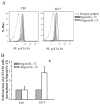

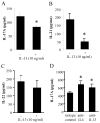
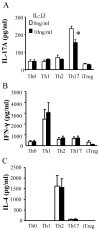
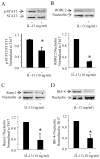
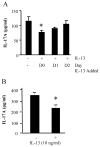
Similar articles
-
A functional IL-13 receptor is expressed on polarized murine CD4+ Th17 cells and IL-13 signaling attenuates Th17 cytokine production.J Immunol. 2009 May 1;182(9):5317-21. doi: 10.4049/jimmunol.0803868. J Immunol. 2009. PMID: 19380778 Free PMC article.
-
Interleukin-23 is critical for full-blown expression of a non-autoimmune destructive arthritis and regulates interleukin-17A and RORgammat in gammadelta T cells.Arthritis Res Ther. 2009;11(6):R194. doi: 10.1186/ar2893. Epub 2009 Dec 17. Arthritis Res Ther. 2009. PMID: 20017902 Free PMC article.
-
IL-17A-producing gammadeltaT cells promote CTL responses against Listeria monocytogenes infection by enhancing dendritic cell cross-presentation.J Immunol. 2010 Nov 15;185(10):5879-87. doi: 10.4049/jimmunol.1001763. Epub 2010 Oct 18. J Immunol. 2010. PMID: 20956351
-
Characterization of a human cervical CD4+ T cell subset coexpressing multiple markers of HIV susceptibility.J Immunol. 2011 Dec 1;187(11):6032-42. doi: 10.4049/jimmunol.1101836. Epub 2011 Nov 2. J Immunol. 2011. PMID: 22048765
-
Interluekin-17A (IL17A).Gene. 2017 May 30;614:8-14. doi: 10.1016/j.gene.2017.01.016. Epub 2017 Jan 22. Gene. 2017. PMID: 28122268 Free PMC article. Review.
Cited by
-
Blockage of Eosinopoiesis by IL-17A Is Prevented by Cytokine and Lipid Mediators of Allergic Inflammation.Mediators Inflamm. 2015;2015:968932. doi: 10.1155/2015/968932. Epub 2015 Jun 23. Mediators Inflamm. 2015. PMID: 26199466 Free PMC article.
-
Th17-mediated inflammation in asthma.Curr Opin Immunol. 2013 Dec;25(6):755-60. doi: 10.1016/j.coi.2013.08.002. Epub 2013 Sep 11. Curr Opin Immunol. 2013. PMID: 24035139 Free PMC article. Review.
-
Transcriptome signature for dampened Th2 dominance in acellular pertussis vaccine-induced CD4(+) T cell responses through TLR4 ligation.Sci Rep. 2016 Apr 27;6:25064. doi: 10.1038/srep25064. Sci Rep. 2016. PMID: 27118638 Free PMC article.
-
Targeting IL-4 for the Treatment of Atopic Dermatitis.Immunotargets Ther. 2020 Sep 29;9:151-156. doi: 10.2147/ITT.S260370. eCollection 2020. Immunotargets Ther. 2020. PMID: 33062619 Free PMC article. Review.
-
Psoriasis harbors multiple pathogenic type 17 T-cell subsets: Selective modulation by risankizumab.J Allergy Clin Immunol. 2025 Jun;155(6):1898-1912. doi: 10.1016/j.jaci.2025.02.008. Epub 2025 Feb 18. J Allergy Clin Immunol. 2025. PMID: 39978685 Free PMC article.
References
-
- Hershey GK. IL-13 receptors and signaling pathways: an evolving web. J Allergy Clin Immunol. 2003;111(4):677–90. - PubMed
-
- Wills-Karp M, Luyimbazi J, Xu X, Schofield B, Neben TY, Karp CL, et al. Interleukin-13: central mediator of allergic asthma. Science. 1998;282(5397):2258–61. - PubMed
-
- Bree A, Schlerman FJ, Wadanoli M, Tchistiakova L, Marquette K, Tan XY, et al. IL-13 blockade reduces lung inflammation after Ascaris suum challenge in cynomolgus monkeys. J Allergy Clin Immunol. 2007;119(5):1251–7. - PubMed
-
- Kumar RK, Herbert C, Webb DC, Li L, Foster PS. Effects of anticytokine therapy in a mouse model of chronic asthma. Am J Respir Crit Care Med. 2004;170(10):1043–8. - PubMed
-
- Yang G, Volk A, Petley T, Emmell E, Giles-Komar J, Shang X, et al. Anti-IL-13 monoclonal antibody inhibits airway hyperresponsiveness, inflammation and airway remodeling. Cytokine. 2004;28(6):224–32. - PubMed
Publication types
MeSH terms
Substances
Grants and funding
- UL1 TR000445/TR/NCATS NIH HHS/United States
- GM015431/GM/NIGMS NIH HHS/United States
- R01 HL 090664/HL/NHLBI NIH HHS/United States
- R01 AI059108/AI/NIAID NIH HHS/United States
- R01 AI 070672/AI/NIAID NIH HHS/United States
- P01 GM015431/GM/NIGMS NIH HHS/United States
- R21 HL106446/HL/NHLBI NIH HHS/United States
- U19 AI095227/AI/NIAID NIH HHS/United States
- R56 AI076411/AI/NIAID NIH HHS/United States
- R56AI076411/AI/NIAID NIH HHS/United States
- R01 HL090664/HL/NHLBI NIH HHS/United States
- R01 AI070672/AI/NIAID NIH HHS/United States
- F32 HL091653/HL/NHLBI NIH HHS/United States
- I01 BX000624/BX/BLRD VA/United States
- R01 AI 059108/AI/NIAID NIH HHS/United States
- P50 GM015431/GM/NIGMS NIH HHS/United States
LinkOut - more resources
Full Text Sources
Other Literature Sources
Research Materials

